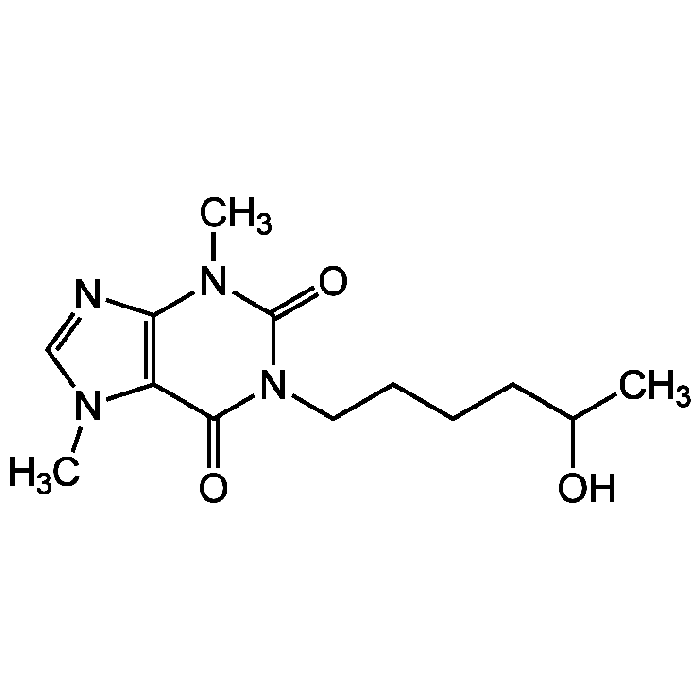Cookie Policy: This site uses cookies to improve your experience. You can find out more about our use of cookies in our Privacy Policy. By continuing to browse this site you agree to our use of cookies.
Chemodex
(±)-Lisofylline

| Product Details | |
|---|---|
| Synonyms | 1-(5'-Hydroxyhexyl)-3,7-dimethylxanthine; LSF; BL 194; CT-1501R; 5-Hydroxy pentoxifylline |
| Product Type | Chemical |
| Properties | |
| Formula | C13H20N4O3 |
| MW | 280.3 |
| CAS | 6493-06-7 |
| Source/Host Chemicals | Synthetic. |
| Purity Chemicals | ≥99% (HPLC) |
| Appearance | White powder. |
| Solubility | Soluble in chloroform. |
| Identity | Determined by NMR. |
| Declaration | Manufactured by Chemodex. |
| Other Product Data |
Click here for Original Manufacturer Product Datasheet |
| InChi Key | NSMXQKNUPPXBRG-UHFFFAOYSA-N |
| Smiles | CC(O)CCCCN1C(=O)N(C)C2=C(N(C)C=N2)C1=O |
| Shipping and Handling | |
| Shipping | AMBIENT |
| Short Term Storage | +4°C |
| Long Term Storage | -20°C |
| Handling Advice |
Keep cool and dry. Protect from light and moisture. |
| Use/Stability | Stable for at least 2 years after receipt when stored at -20°C. |
| Documents | |
| MSDS |
 Download PDF Download PDF |
| Product Specification Sheet | |
| Datasheet |
 Download PDF Download PDF |
Synthetic methylxanthine metabolite of pentoxifylline. Potent anti-inflammatory agent in which only the (−) optical isomer is biologically active. Inhibits the generation of phosphatidic acid from cytokine-activated lysophosphatidic acyl transferase (LPAAT), which has been shown to protect mice from endotoxic shock. Decreases lipid peroxidation in vitro and in vivo. Suppresses the production of the proinflammatory cytokine IFN-γ, inhibits IL-12-mediated STAT-4 activation, enhances glucose-stimulated β-cell insulin secretion, reducing the onset of diabetes in a non-obese diabetic mouse model, and blocks autoimmune deterioration of pancreatic β cells in non-obese diabetic mice. Compound can be used as analytical reference material.
(1) G.C. Rice, et al.; PNAS 91, 3857 (1994) | (2) E. Clarke, et al.; Cancer Res. 56, 105 (1996) | (3) N. Hasegawa, et al.; Am. J. Respir. Crit. Care Med. 155, 928 (1997) | (4) S. Itani, et al.; Metabolism 50, 553 (2001) | (5) S. Itani, et al.; Diabetes 51, 2005 (2002) | (6) M. Chen, et al.; Endocrinol. 143, 2341 (2002) | (7) Z. Yang, et al.; Ann. N.Y. Acad. Sci. 1005, 409 (2003) | (8) J.S. Striffler, et al;.Metab. Clin. Exp. 53, 290 (2004) | (9) Z. Yang, et al.; Biochem. Pharmacol. 69, 1 (2005) | (10) E. Wyska; Pharmacology 85, 264 (2010)





